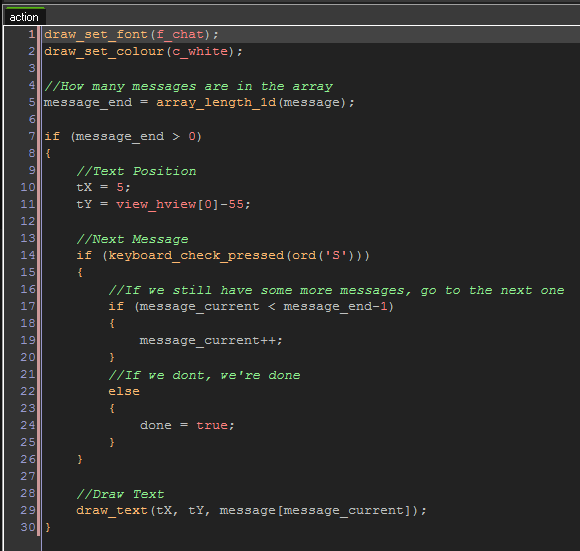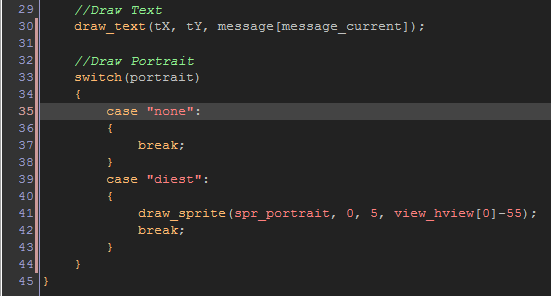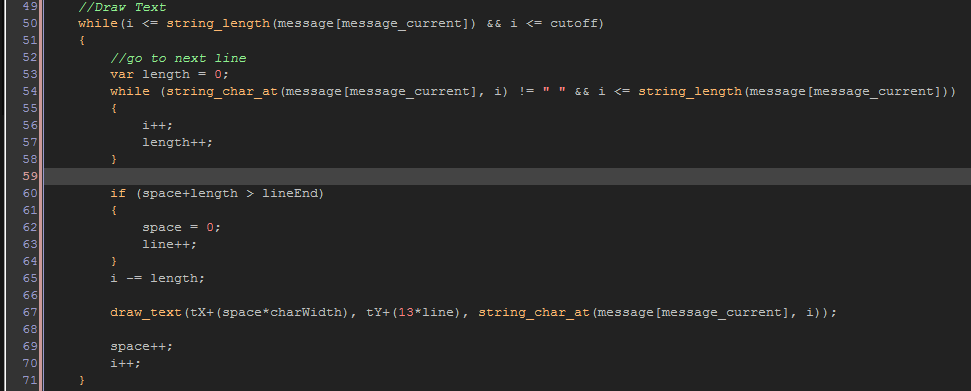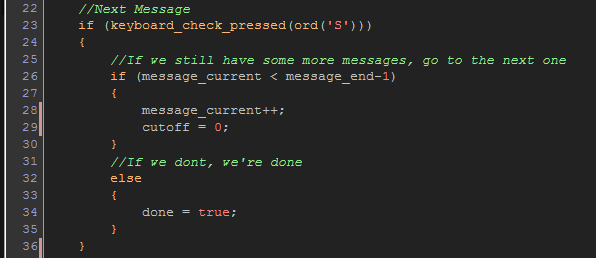Lets Get Started:
Ok so start up a new project. Now the first thing I’ve done is create a pixel perfect camera so everything looks nice and crisp. If you haven’t read my Pixel Perfect Camera Tutorial I suggest you take a look at that first.
Everything nice and pixel perfect now? Good! Let’s move on.
Before we head any further, one thing you’re going to need is a Monospaced font. These are fonts that have a fixed-width and is something we’re going to take into account later on. You can find free ones online, and I’m sure you already have some installed onto your computer. “Courier” is a monospaced font.
Now let us take a second to think of what we want our dialogue boxes to have.
- Display text
- Display portrait
- Typewriter text effect
- Misc. other text effects
So now lets implement them in this order.
Display Text:
Create a new object, name it something like “obj_dialogue” and give it a Create event with this code:

message is an array containing all the messages you want to display.
message_current is the current message to display.
I’ll explain the rest of them later, for now this is all we need.
Now add a Draw GUI event and lets add some code to it.

Comments in the code explain what each section does but here’s a summary: We create a variable (message_end) that stores how big the message array is. If its bigger than 0 we draw the current message. If the user presses S, we either go to the next message in the array, or we make done equal to true, which we’ll make destroy the object later.
and there we go, we now have it display text and scroll through each message when you press S.

Display Portrait:
Now we’re going to add portraits to the dialogue box.
If you take a look at the create event, you’ll see we have a “portrait” variable that is a string. We’ll make it so depending on what you set the variable to, it’ll display the corresponding portrait.
Open up the Draw GUI code and let’s add code under the Draw Text section.

Here we added a switch statement which will read the “portrait” variable and then display the corresponding portrait and have the option to NOT display a portrait.
Also, we’ll adjust the Text Position section so the text moves over depending on if there is a portrait or not.

I have a sprite named “spr_portrait” which contains my self portrait (size 50×50), I changed the “portrait” variable to “diest” and here is the result:

Typewriter Text Effect:
This is where things get tricky. We’re going to make the text come in one character at a time. This can be done in several different ways (like adding to a string) but the way we’re going to do it is to draw each character separately. This way we can add cool effects later on as seen in the top gif.
Open up the Draw GUI code and we’re going to add/edit it.
We now need to add these variables to the top of the message_end if statement:

Remember when I said you’re going to need a monospaced font? Here’s why, we have a “charWidth” variable that is going to contain the fixed-width of your font (this entirely depends on the font you use and the size you set it. In my case the size is 8, so I set it to 7 just so the letters are close together but still readable.)
“lineEnd” contains the amount of characters you want in a single line. This way once a line contains more characters than this amount, it will go to the next line.
“line” is the current line we’re on.
“space” is like the character count. For example if the message is “Hello” then “H” is character 0, “e” is character 1, and so on.
we use “i” for looping purposes which you’ll see in a second. Almost like a for-loop.
“delay” is time delay we want before writing the next character.
Let’s implement this.
Add this code somewhere within the message_end if statement:

Now we’re using the “cutoff” variable. This is the variables we’re going to use to cutoff the current message and write out each character. Since we start at 0, it will write 0 characters. When the timer goes off cutoff will equal 1 and it’ll write 1 character, and so on.
Let’s make that happen.
Edit the Draw Text section to this:

So now we’ve added a While loop to the Draw Text section. Remember we need to draw each character in the message individually, so we’re going to need a loop for this.This while loop only runs if “i” is less/equal to the length of the message AND less/equal to “cutoff”. So if the length of the message is 20 but the cutoff is 5, it will only display 5 characters.
First thing we do inside the while loop is check to make sure the current word doesn’t surpass the “lineEnd” variable, and if it does we go to the next line.
Now the “draw_text” function no longer draws the entire string, it is now drawing each character individually, so we have to manually space them out.
“tX+(space*charWidth)” is doing exactly this.
Remember “space” is like the character count, so we multiply this by the charWidth. So if “space” is equal to 3 and charWidth is equal to 7,
7 X 3 = 21, so the third character will be 21 pixels to the right of the tX position.
ALSO, we have to reset the “cutoff” variable back to 0 when we go to the next message, so add that to this section:

Once we do all this, we increment the “space” and “i” variables to move on to the next character. Here is the result:

Other Text Effects:
Now that we are drawing each character separately, we can add effects on each character with a little effort.
First thing we need is some sort of way to let our system know what effects we want on which characters. Let’s implement something I call a “modifier.”
add this code inside the while loop that draws each character:

Here we are checking our message for a modifier. As you can see, my modifier is a backwards slash. You can make it anything you want, but I suggest you use a special character that you wouldn’t regularly use in your game dialogue.
Basically how this will work is we will set a modifier to the text we want with effects. So if we want an effect on the message “Hello World!” we’ll change it to “\1Hello World!”
As you can see, in the if statement we have two “++i” so the modifiers will not be displayed when we draw the text.
Now lets make these modifiers actually do something.
First lets add normal, no effect text.

We have a modifier for normal plain text. This will be done by the modifier “\0″ so an example of this would be “\0Hello World!”
Now lets add another modifier.
How about shaky text?

What we’re doing is adjusting the X and Y position of each shaky character by adding to it with “random_range(-1, 1)” and we implement this by adding “\1″ to the section we want shaky.
So if you want a combination of modifiers, we’ll do something like:
“\0Hello \1World\0!”
And now adding this to your message array will result in:

Finished!
And we’re done! You can now add any modifier you can think of. Change the text color by adjusting the “draw_set_colour” function, or whatever else!
Please let me know if you guys have any questions or anything is unclear. Also it’d be awesome if you could share this.

my modifier part isn’t working and I don’t know why, it’s not drawing the \1 and \0 like its supposed to but I’m not getting any shaky text
Its difficult to help without being able to see your code. Maybe you aren’t reading in the modifier correctly?
write in some code that will print out what the modifier variable holds.
Hey! I was wondering how to do a thing where if the player presses the S key in this example before the message is finished showing, it finishes the message immediately, but doesn’t move on to the next message. In your example, if you press it before the message is finished, it moves on to the next one right then. Thanks!
Hey Diest ! I’m just wondering how you can play a little talking sound when a letter s typed… Thanks you for answering ! Really good tutorial by the way, well explained 🙂 Keep up the good work dude !
Hey there! So you want to do it everytime a letter is typed out. Where in the code do we handle typing out each individual character? This is where you’d want to play your sound. (hint: typewriter section of tutorial)
Hi Michael, so I’ve ran into a bit of an issue with the “Other Text Effects” section. After adding in the check for modifier and the switch, it causes the game to crash with the error message, “Variable obj_dialogue.modifier(100039, -2147483648) not set before reading it.
at gml_Object_obj_dialogue_DrawGUI_1 (line 92) – case 0: ”
I’m not sure exactly what would be causing the issue. According to a friend of a friend, the modifier variable called in the if statement seems to be the cause of the issue because GameMaker isn’t sure what to do with it, but I would like to ask your opinion.
Just a quick update, so it turns out that I didn’t create the instance variable in the create event and setting it to 0 seems to have fixed my issue.
Glad you figured it out!
I’ve tried increasing the size of the font but it comes out all misaligned, how would you fix that.
Please review the “Typewriter Text Effect” section!
You need to adjust the charWidth variable and then you need to adjust the draw_text function to adjust the space between lines of text.
To make it more versatile with other fonts, couldn’t you set charWidth=string_width(string_char_at(message[message_current],i)) with ever iteration of the while loop.
Then instead of of doing space++, you could would do space+=charWidth. Lastly, for the x coordinate of any draw_text function, you would write tX+space as space now contains the width of every character up to that point.